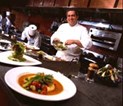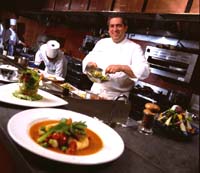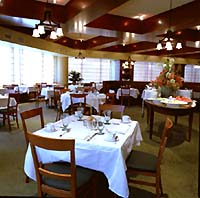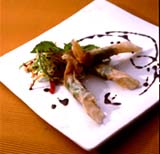Culinary Notes: An Interview with Executive Chef John Coletta

Noted in culinary circles as a rising star, the executive chef at the Caliterra Cal-Ital Bar & Grille at Chicago's Wyndham hotel discusses food trends, labor challenges and the unique passion required to run an upscale hotel restaurant.
Table of Contents
Diverse Guests
Labor Challenges
Menu Creation
Trendsetters
By Nancy Ross Ryan
 Ever since James Hilton's 1933 novel Lost Horizons, which describes the beautiful imaginary land of Shangri-La, that word has come to define perfection. Take the five-star Shangri-La Hotel in Singapore, for example. It is a flagship property rated the best hotel in Singapore by Money magazine with the finest facilities and, from a chef's point of view, the best ingredients from all over the world, a highly motivated labor force, and a distinguished clientele.
Ever since James Hilton's 1933 novel Lost Horizons, which describes the beautiful imaginary land of Shangri-La, that word has come to define perfection. Take the five-star Shangri-La Hotel in Singapore, for example. It is a flagship property rated the best hotel in Singapore by Money magazine with the finest facilities and, from a chef's point of view, the best ingredients from all over the world, a highly motivated labor force, and a distinguished clientele.
So why would John Coletta give up his prestigious job as executive chef after only two years to return to Chicago?
Q: So why did you leave Shangri-La?
A: With regrets. It was a dream job. Why? For a couple of reasons: My wife and I were planning a family. We now have a nine-month old daughter, and my wife planned to give up her career for the next few years to raise our daughter--and she didn't want to do it in Singapore. She has family in Chicago.
Q: That's one good reason. You said a couple.
A: Well, yes. The other one is ulterior. I really want to show people that hotel dining can be first rate, the way it used to be a few decades ago when hotel dining rooms and hotel chefs created the best food imaginable. In my opinion the best food today is being done in independent restaurants and the best place to open a new restaurant is near a hotel!
Diverse Guests
 Q: You have been a chef in the hotel business for a long time in many different styles of hotels. Notice any difference in the profile of the average hotel guest? Are business travelers more demanding? Are leisure travelers different here than in Asia?
Q: You have been a chef in the hotel business for a long time in many different styles of hotels. Notice any difference in the profile of the average hotel guest? Are business travelers more demanding? Are leisure travelers different here than in Asia?
A: Oh yes the hotel guest has changed! On the average people are becoming more demanding of quality and variety in food, but perhaps less demanding of quality in service. As for the business traveler, research has demonstrated the need for less complicated experiences for the business traveler. He or she is looking for a straightforward reliable experience. A room if just a room. They don't want to gamble or be overwhelmed; they don't want to be guinea pigs. They want basic comfort foods that are not overdone, but have integrity in the dish and its preparation.
Lesiure travelers, especially families with children, have entirely different expectations that center on friendly approachable food and service. For both the family and the business traveler, the food needs to keep pace with the time but not necessarily be cutting edge. The leisure traveler in Asia is entirely different, especially those who stay in five-star hotels. They want sophisticated service, and the finest of food and beverage--for example, ripest seasonal fruits placed in their rooms, and impeccable ingredients and execution in the hotel restaurants whether they be Chinese, or Western-style. The use of exotic ingredients--sharks' fin, abalone, birds' nest--is pronounced. These travelers show their sophistication through what and where they eat, stay, wear and drive (usually chauffeur-driven cars). Price is not as important as the high value of the experience.
Q: So who are your customers and what appeals to them
A: They span all ages and include hotel guests and Chicagoans who know we're here. Our guests want the same things that most customers these days want: comfortable, identifiable food that is simple, focuses 65% on ingredients and 35 percent on craftsmanship, served in a contemporary vessel--with a twist but not a distortion. Customers can't always articulate what they want completely. So it's almost like a gamble. But it you get the best ingredients, that's a start. Then you look at food memories, many of which are regional such as Texas barbecue, New England lobster, Midwestern pot pie. I can do a lobster pot pie.
Q: As a hotel chef, you can go two ways---corporate executive chef of a big hotel chain, or executive chef of a single hotel fine-dining restaurant. Why did you choose the latter?
A: Food turns me on. It still does today. That's why I'm not sitting in a corporate office anymore. The challenge is to find a company that will allow you to achieve your passion and also certain financial goals.
Q: Isn't achieving your passion enough?
A: Not when you reach a certain age. Chefs work so hard, literally double shifts for years and years. A body can only take so much. I don't know too many head chefs who stand behind the stove and cook 12 hours a day.
Q: Is that why you didn't open your own independent restaurant?
A: That and a few million dollars. Today you can open the doors on many kinds of business for about $150,00.00. To open a restaurant you need at least $1.5 million--and one-third of that liquid.
Q: So how long do you work each week?
A: 100 hours.
Q: Can you do that for the rest of your life?
A: Probably not. I get up, have breakfast, play with my daughter--then go to work for 11 or 12 hours. But still, I have never felt that cooking was a burden.
Labor Challenges
 Q: What's the biggest challenge you face today---food cost or labor?
Q: What's the biggest challenge you face today---food cost or labor?
A: Probably labor. Today in our society, the service industry has a huge challenge attracting enough passionate people who really care and want to learn.
Q: What is the biggest training challenge you have faced?
A: I still face it--motivation. Training techniques become almost secondary--how to cut, puree, sautee, arrange, garnish. But finding people who are enthusiastic about this profession and willing to learn and achieve--that's the hard part. In Western and Asian society the foodservice industry is challenged. The labor force demands higher and higher wages. That adds to the pressure when you try to prepare 100% of your products in-house. If you decide to do that, your price structure has to reflect that.
But in addition to higher wages there are two more factors: The window of time for making someone into a sous chef has shortened. It legitimately takes about 10 years from graduation from culinary school. You don't have that kind of time today. You have to do it in five. And it's difficult for anyone to acquire solid culinary and management skills in that time. Business is not committed to full training and development. Personally, I spend six to eight hours of my time every day training the staff--in everything. We look to improve every dish on the menu every day.
Q: So does everyone get up to speed eventually?
A: You have to allow cooks to grow and develop. It takes time and everybody evolves at a different pace. We all have our own rhythms. And a lot depends on our lives, families, dispositions. Sometimes I thank the families of our staff for letting them focus on their work. Some receive minimal training but they have a deep focus and can achieve noteworthy results.
Q: Your menu looks pretty labor-intensive--everything from scratch. Couldn't you cut labor costs and training hours with at least some convenience products?
A: The more we move toward cooking simple food, the more particular we have to be about the ingredients. Not only the ingredients themselves, but receiving standards, handling standards, building relationships with suppliers. Their credibility is so important to satisfying our guests. What happens to the menu if the supplier can't keep the quality promise or can't deliver?
Q: What about food cost? Your menu features some pretty pricey ingredients.
A: When you first open a new restaurant, you establish targets and goals that you want to achieve, because you will have a higher than normal food cost the first year. But that being said, figuring food cost is one of those things that is as fundamental as balancing your check book. If you don't have the systems in place--food, labor and beverage costs in control-- then you don't really have a passion for this business. And a great restaurant is a business. It's so simple, really. If shrimp costs you $10 per pound, a four-ounce portion costs $2.50. You start multiplying what you can charge for shrimp.
Menu Creation
Q: I don't see shrimp cocktail on your menu. But I do see Shrimp "Cigars" for $9.
A: People want things they recognize, identifiable food. They like shrimp, like crisp fried things, like cole slaw. But they also want variety, a new twist. This combines all three--shrimp rolled in a thin wrapper, crisply fried, drizzled with a tangy balsamic syrup and crisp vegetable slaw . It has become a popular core menu item that we don't dare change.
Q: How often do you change your menu?
A: We change the core menu four times a year with the seasons--except for those signature items that are so popular they have to be there. And then we have daily seasonal specials at lunch and dinner.
Q: How big is your menu, and how big should it be ideally?
A: Our dinner menu is about 28 items, prior to dessert. The size of our menu is predicated on what we do best, on the size of our physical plant. We focus on higher quality food and fewer selections. The old menus of 60 or 70 items that offered something for everyone are a thing of the past. We can't be all things to all people. But we can feature those items that appeal to our customers. And, as the staff becomes more skilled, perhaps we can increase the menu slightly.
Trendsetters
Q: I read some trend forecaster the other day who said that pasta was passe and going to be replaced by rice as the carbohydrate of choice.
A: Well, I think there is room for rice, for real risotto in the hands of cooks who know how to prepare it properly, and for all the new rice varieties including organic rice. But, hey, I can't imagine someone saying, "Let's go out for some rice tonight." I think pasta and pizza are here to stay and are platforms for lots of variations.
Q: Are there any carbohydrate trends?
A: Yes. Hot breads made to order. Now we bake breads in the morning that won't be served until afternoon. I see interest in East Indian foods--not only the spices, but the cooking techniques. What could be simpler and more immediate than Naan bread baked to order in a tandoori oven and served hot! Asian ingredients and techniques such as wok cookery are making their way into mainstream restaurants.
Q: What chefs do you admire and why?
A: Many, but especially Thomas Keller of the French Laundry (Yountville, CA) and Gray Kunz who just left Espinasse in New York. Keller for the complexity of the flavors and depth he brings to the foods not by complex preparation or altering them but by letting them unfold their flavors. And Kunz who finally found and has developed the perfect blend of Asian-Western cooking and ingredients.
Q: So at the end of the day, whose job is harder--yours or your wife's?
A: I have to say probably my wife's. It's all so new. She is faced with things that no one has prepared her for. There's no formatting! Sunday night she asked me if I would watch the baby for a couple hours while she went out. I said, "No problem." By the time she came back I was climbing the walls.
About the Chef: Culinary Vitae
Chef: John Coletta
Age: 46
Education: The Culinary Institute of America, pastry courses; New York City Technical College, Associates' degree in culinary arts.
Experience: Pastry apprentice, St. Regis Hotel, New York;Apprentice cook, Waldorf Astoria, New York; Cook, Four Seasons, New York; Cook, La Coup de Fusil French restaurant, New York; Chef de cuisine, King's Crown Restaurant, Captiva Island; Chef de cuisine, Nikolai's Roof, Atlanta; Executive Chef, Rye Town Hilton, New York; Executive Chef, Harbor Island Hotel, Tampa, FL; Opening Executive Chef, Fairmont Hotel, Chicago; Opening Chef, Streeterville Restaurant, Sheraton Chicago Hotel and Towers; Executive Chef, Caesar's Palace, Las Vegas; Executive Chef, Shangri-La hotel, Singapore.
Coletta's Trends to Watch:
• Regionalization of foods--New England lobster and shad roe, Texas barbecue--and exporting those foods to other regions.
• Elevation of humble foods--potato, tomato, spareribs, mushrooms--to
exciting restaurant dishes.
• Adding flavor and textures--turning dried fruits, spices, mushrooms, into
powders and crusts.
• Affinity with Italian products--pizza, pasta, risotto, etc.
• Divsersity of steakhouses at all levels: Brazilian, Tuscan, etc.
• Seafood restaurants
• Bar/restaurants--a meeting, eating place with music.
• More Asian cooking techniques
Dinner Menu Sampler
Starters:
• Santa Barbara shrimp "cigars" with mustard fruits, summer vegetable
slaw and aged balsamic syrup, $9
• Grouper cheeks in a "Cioppino" broth with sea beans and lemon aioli, $10
• Ahi Tuna tartar with avocado, cucumber and sterling caviar, $9
Soups and Salads:
• Summer pea "cappuccino" with white truffle oil, $8
• Tomato salad, $7
• Organic field greens with fresh herbs, Gorgonzola fritter, pears and
walnut vinaigrette, $8
• Hearts of Romaine a la Caesar with white anchovies and ciabatta
crostini, $6
Brick Oven Pizza
• Roasted vegetable pizza with ricotta salata and oil cured olives, $11
• Spicy lamb sausage pizza with arugula pesto, roasted peppers and
caramelized onions, $13
Pasta
• Angel hair pasta with tomatoes and sweet basil, $11
• Yukon gold potato gnocchi with Maine lobster "Bolognese", $18
• Veal ravioli with crispy sage, veal bacon, summer pea shoots and yellow
Bell pepper essence, $15
Specialties
• Oven roasted organic chicken breast with prosciutto and sage on soft
mascarpone polenta with fig-balsamic essence, $17
• Sonoma lamb loin with barley caponata risotto and chanterelles, $24
• Pan seared wild salmon with herbed risotto, mushrooms and celery-saffron
juices, $21
• Five spice seared Sonoma duck breast with pearl pasta, braised Belgian
endive, fava beans and sun-dried cherries, $22
• Grilled aged Angus sirloin of beef with onion marmalade,lemon-pepper-Parmesan fries and red Bell pepper aioli, $25
